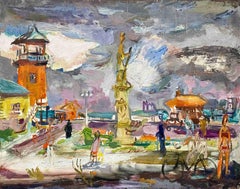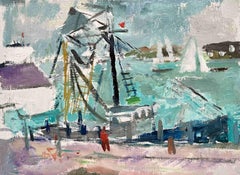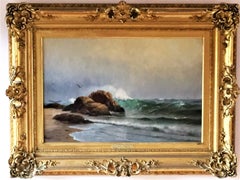Masonite Landscape Paintings
to
2
4
4
4
3
1
Overall Height
to
Overall Width
to
4
4
2
1
4
1
3
13
7
5
4
4
7
7
4
4
2
Artist: Francis Chapin
Medium: Masonite
Untitled (Martha’s Vineyard)
Located in Chicago, IL
A colorful view of Martha's Vineyard (Depicting Edgartown's main street) by Francis Chapin, from around 1950.
Francis Chapin, affectionately called the “Dean of Chicago Painters” by...
Category
1950s American Modern Masonite Landscape Paintings
Materials
Masonite, Oil
Yellow Sky at Menemsha
Located in Chicago, IL
A colorful view of Menemsha in Martha's Vineyard by Francis Chapin, from around 1950.
Francis Chapin, affectionately called the “Dean of Chicago Painters” by his colleagues, was one...
Category
1950s American Modern Masonite Landscape Paintings
Materials
Masonite, Oil
Oak Bluffs, Mass. (Martha’s Vineyard)
Located in Chicago, IL
A view of Oak Bluffs, MA on Martha's Vineyard by Francis Chapin, from around 1950.
Francis Chapin, affectionately called the “Dean of Chicago Painters” by his colleagues, was one of...
Category
1950s American Modern Masonite Landscape Paintings
Materials
Masonite, Oil
Untitled (Vineyard Harbor)
Located in Chicago, IL
A colorful view of Martha's Vineyard by Francis Chapin, from the 1930s.
Francis Chapin, affectionately called the “Dean of Chicago Painters” by his colleagues, was one of the city’s most popular and celebrated painters in his day. Born at the dawn of the 20th Century in Bristolville, Ohio, Chapin graduated from Washington & Jefferson College near Pittsburgh, Pennsylvania before enrolling at the Art Institute of Chicago in 1922. He would set down deep roots at the Art Institute of Chicago, exhibiting there over 31 times between 1926 and 1951. In 1927 Chapin won the prestigious Bryan Lathrop Fellowship from the Art Institute – a prize that funded the artist’s yearlong study trip to Europe. Upon his return to the United States, Chapin decided to remain in Chicago, noting the freedom Chicago artists have in developing independently of the pressure to conform to pre-existing molds (as was experienced by artists in New York, for example). Chapin became a popular instructor at the Art Institute, teaching there from 1929 to 1947 and at the Art Institute’s summer art school in Saugatuck, Michigan (now called Oxbow) between 1934 – 1938 (he was the director of the school from 1941-1945).
A prolific painter, Chapin produced numerous works while traveling in Mexico, France, Spain, Saugatuck and Martha’s Vineyard, where he frequently spent summers and taught at the Old Sculpin Gallery there. Chapin was best recognized for his dynamic and vibrant images of Chicago during the 1930s and 40s. Chapin was a resident of the Old Town neighborhood where he lived and kept his studio on Menomonee Street for many years. Described as a “colorful figure, nearly 6 feet 6 inches tall, and thin, and usually wearing tweeds”, it is easy to imagine Chapin at work observing the busy street life of the city.
In addition to his many exhibitions at the Art Institute of Chicago, Chapin’s work was shown during his lifetime at such institutions as the Pennsylvania Academy of Fine Arts, Philadelphia; the Corcoran Gallery, Washington, D.C.; the National Academy of Design, New York; the Museum of Modern Art, New York; the Whitney Museum of American Art, New York and the Carnegie Institute, Pittsburgh, among others. Francis Chapin’s paintings are represented in the collections the Art Institute of Chicago; the Friedman Collection, Chicago; the Butler Institute of American Art, Youngstown; the Denver Art Museum; the Everson Museum of Art, Syracuse; the Norton Museum of Art, West Palm Beach...
Category
1930s American Modern Masonite Landscape Paintings
Materials
Masonite, Oil
Related Items
Large 1960 California "Abstract Landscape" Jack Stuck Painting
Located in Arp, TX
Jack Stuck (1925-1993)
"Abstract Landscape"
1960
Collage oil paint, charcoal, paper and canvas laid down on masonite
48"x46" natural wood frame 51" x 49"
Si...
Category
Mid-20th Century American Modern Masonite Landscape Paintings
Materials
Canvas, Masonite, Charcoal, Oil, Laid Paper
H 49 in W 51 in D 2 in
The Surf at Newport
Located in Storrs, CT
The Surf at Newport (Rhode Island). c. 1906. Oil on canvas. 17 x 24 (framed 26 x 34). Lined; extensive craquelure; otherwise fine condition. Housed in an exceptional Louis XV (reviva...
Category
Early 20th Century American Modern Masonite Landscape Paintings
Materials
Oil
Blue Lake
Located in Los Angeles, CA
This painting is part of our exhibition America Coast to Coast: Artists of the 1940s.
Blue Lake, c. 1940s, oil on masonite, signed lower right, 20 x 36 inches, label and inscriptio...
Category
1940s American Modern Masonite Landscape Paintings
Materials
Masonite, Oil
Vintage Modernist Landscape Painting, Monument Valley Arizona, listed artist
Located in Baltimore, MD
Although born in Ohio at the end of the 19th century, Martin Sabransky studied art at Randolph Macon College in Virginia. He began his career path moving west, by first going to Kans...
Category
Mid-20th Century American Modern Masonite Landscape Paintings
Materials
Oil
Untitled (Farm in Winter)
By Julius M. Delbos
Located in Los Angeles, CA
This work is part of our exhibition America Coast to Coast: Artists of the 1940s
Untitled (Farm in Winter), 1940s, oil on canvas, signed lower right, 26 x 30 inches, presented in an original frame
Julius Delbos...
Category
1940s American Modern Masonite Landscape Paintings
Materials
Canvas, Oil
Vintage Rockwell Kent Copy of "Vermont Winter 1921" Oil on Canvas Painting, 1960
Located in Baltimore, MD
This large painting is a ca. 1960 copy of a famous Rockwell Kent painting that was executed in Vermont in 1921. The work is oil on canvas and well represents the original image, tho...
Category
1960s American Modern Masonite Landscape Paintings
Materials
Oil
H 25 in W 30 in D 3 in
Simka Simkhovitch WPA Artist Oil Painting American Modernist Landscape Pond Tree
Located in Surfside, FL
Simka Simkhovitch (Russian/American 1893 - 1949)
This came with a small grouping from the artist's family, some were hand signed some were not.
Thes...
Category
1930s American Modern Masonite Landscape Paintings
Materials
Oil, Board
My Only Working Tool
Located in Los Angeles, CA
My Only Working Tool, 1949, oil on panel, signed and dated lower right, 16 x 12 inches, remnant of exhibition label verso, exhibited at the Art News Second Annual National Amateur Co...
Category
1940s American Modern Masonite Landscape Paintings
Materials
Oil, Board
1972 Gestural Oil Painting Boat in Harbor Figural Abstraction Raoul Middleman
By Raoul Middleman
Located in Surfside, FL
Raoul Middleman (born 1935 in Baltimore, Maryland) is an American painter. Middleman has been a member of the Maryland Institute College of Art faculty since 1961. American University Museum at the Katzen Center has described Middleman as a "Baltimore maestro [whose] nudes are not pretty—they are sagging, dimpled, and real. His cityscapes reveal the underbelly of post-industrial rot, his narrative paintings give contemporary life to his personal obsessions. They are intelligent, messy, and utterly masterful."
From an interview with RM "I was doing abstract art. Then Roy Lichtenstein came around, and I wanted to be current. I remember Grace Hartigan said, “You’ve gotta go to New York, seize destiny by the hand.” My friend Jon Schueler took my slides up to Eleanor Ward, who had the Stable Gallery. My Pop art paintings were discovered. I moved to New York into Malcolm Morley’s old loft down on South Street. Agnes Martin was upstairs... People who interest me come from different quarters. I knew guys around Schueler, like B.H. Friedman. But I also knew the Pop world pretty well – Al Hansen, Richard Artschwager, Lichtenstein. I became friends with Raoul Hague and I rented a place in Port Jervis, New York. I started doing my first landscapes up there. I thought making landscapes was the dumbest thing you could do. You got flies, insects, cow pies, humidity. But I loved it... I went down to the meetings of the Figurative Alliance. I met my friends there — Paul Resika, Paul Georges, Rosemarie Beck...
Category
1970s American Modern Masonite Landscape Paintings
Materials
Oil, Board
A Valley Streetscape at Night
Located in Los Angeles, CA
This work is part of our exhibition - American Coast to Coast: Artists of the 1940s
A Valley Streetscape at Night, 1948, oil on masonite, signed and dated lower right, 18 x 24 inch...
Category
1940s American Modern Masonite Landscape Paintings
Materials
Masonite, Oil
Simka Simkhovitch WPA Artist Oil Painting American Modernist Landscape w Tower
Located in Surfside, FL
Simka Simkhovitch (Russian/American 1893 - 1949)
This came with a small grouping from the artist's family, some were hand signed some were not.
Thes...
Category
1930s American Modern Masonite Landscape Paintings
Materials
Oil, Board
Simka Simkhovitch WPA Artist Oil Painting Gouache American Modernist Powerline
Located in Surfside, FL
Simka Simkhovitch (Russian/American 1893 - 1949)
This came with a small grouping from the artist's family, some were hand signed some were not.
These were studies for larger paintings.
Simka Simkhovitch (Симха Файбусович Симхович) (aka Simka Faibusovich Simkhovich) (Novozybkov, Russia May 21, 1885 O.S./June 2, 1885 N.S.—Greenwich, Connecticut February 25, 1949) was a Ukrainian-Russian Jewish artist and immigrant to the United States. He painted theater scenery in his early career and then had several showings in galleries in New York City. Winning Works Progress Administration (WPA) commissions in the 1930s, he completed murals for the post offices in Jackson, Mississippi and Beaufort, North Carolina. His works are in the permanent collections of the Dallas Museum of Art, the National Museum of American Art and the Whitney Museum of American Art. Born outside Kyiv (Petrograd Ukraine) into a Jewish family who owned a small department store. During a severe case of measles when he was seven, Simcha Simchovitch sketched the views outside his window and decided to become an artist, over his father's objections. Beginning in 1905, he studied at the Grekov Odessa Art School and upon completion of his studies in 1911 received a recommendation to be admitted to the Imperial Academy of Arts. Though he enrolled to begin classes in architecture, painting, and sculpture at the Imperial Academy, he was dropped from the school roster in December because of the quota on the number of Jewish students and drafted into the army. Simchovitch served as a private in the 175th Infantry Regiment Baturyn [ru] until his demobilization in 1912. Re-enrolling in the Imperial Academy, he audited classes.
Simka Simkhovitch exhibited paintings and sculptures in 1918 as part of an exhibition of Jewish artists and in 1919 placed 1st in the competition "The Great Russian Revolution" with a painting called "Russian Revolution" which was hung in the State Museum of Revolution. In 1922, Simkha Simkhovitch exhibited at the International Book Fair in Florence (Italian: Fiera Internazionale del Libro di Firenze). In 1924, Simkhovitch came to the United States to make illustrations for Soviet textbooks and decided to immigrate instead. Initially he supported himself by doing commercial art and a few portrait commissions. In 1927, he was hired to paint a screen for a scene in the play "The Command to Love" by Fritz Gottwald and Rudolph Lothar which was playing at the Longacre Theatre on Broadway. Art dealers began clamoring for the screen and Simkhovitch began a career as a screen painter for the theater. Catching the attention of the screenwriter, Ernest Pascal, he worked as an illustrator for Pascal, who then introduced him to gallery owner, Marie Sterner. Simkhovitch's works appeared at the Marie Sterner Gallery beginning with a 1927 exhibit and were repeated the following year. Simkhovitch had an exhibit in 1929 at Sterner's on circus paintings. In 1931, he held a showing of works at the Helen Hackett Gallery, in New York City and later that same year he was one of the featured artists of a special exhibit in San Francisco at the California Palace of the Legion of Honor in Lincoln Park. The exhibit was coordinated by Marie Sterner and included four watercolors, including one titled "Nudes". He is of the generation of Russian Soviet artists such as Isaac Pailes, Serge Charchoune, Marc Chagall, Chana Orloff, Isaac Ilyich Levitan, and Ossip Zadkine.
In 1936, Simkhovitch was selected to complete the mural for the WPA Post office project in Jackson, Mississippi. The mural was hung in the post office and courthouse in 1938 depicted a plantation theme. Painted on the wall behind the judge’s bench, “Pursuits of Life in Mississippi”, a depiction of black workers engaged in manual labor amid scenes of white professionals and socialites, was eventually covered over in later years during renovations due to its stereotypical African American imagery. Simka painted what he thought was typical of Jackson. His impression of pre-civil rights Mississippi was evidently Greek Revival column houses, weeping willow trees, working class families, and the oppression of African Americans. He painted African American men picking cotton, while a white man took account of the harvest and a white judge advised a white family, calling it Pursuits of Life in Mississippi.
Though clearly endorsed by the government and initially generally well-received, the mural soon raised concerns with locals as the climate toward racial segregation began to change. The main concern was whether depictions that show African Americans in subjugated societal roles should be featured in a courtroom. The following year, his painting "Holiday" won praise at an exhibition in Lincoln, Nebraska. In 1940, Simkhovitch's second WPA post office project was completed when four murals, "The Cape Lookout Lighthouse and the Orville W. Mail Boat", "The Wreck of the Crissie Wright", "Sand Ponies" and "Canada Geese" were installed in Beaufort, North Carolina. The works were commissioned in 1938 and did not generate the controversy that the Jackson mural had. The main mural is "The Wreck of the Crissie Wright" and depicts a shipwreck which had occurred in Beaufort in 1866. "The Cape Lookout Lighthouse and the Orville W. Mail Boat" depicted the lighthouse built in 1859 and the mail boat that was running mail during the time which Simkhovitch was there. The boat ran mail for the area until 1957. "Sand Ponies" shows the wild horses common to the North Carolina barrier islands and "Canada Geese" showed the importance of hunting and fishing in the area. All four murals were restored in the 1990s by Elisabeth Speight, daughter of two other WPA muralists, Francis Speight...
Category
1930s American Modern Masonite Landscape Paintings
Materials
Gouache, Oil, Board
Masonite landscape paintings for sale on 1stDibs.
Find a wide variety of authentic Masonite landscape paintings available on 1stDibs. While artists have worked in this medium across a range of time periods, art made with this material during the 21st Century is especially popular. If you’re looking to add landscape paintings created with this material to introduce a provocative pop of color and texture to an otherwise neutral space in your home, the works available on 1stDibs include elements of green, orange and other colors. There are many well-known artists whose body of work includes ceramic sculptures. Popular artists on 1stDibs associated with pieces like this include Michael Baxte, Charles Ford, Francis Chapin, and Helen Enoch Gleiforst. Frequently made by artists working in the Impressionist, Modern, all of these pieces for sale are unique and many will draw the attention of guests in your home. Not every interior allows for large Masonite landscape paintings, so small editions measuring 0.1 inches across are also available
Recently Viewed
View AllMore Ways To Browse
1930s French Impressionism
Byzantine Icons
California Turn Of The Century Impressionist
Canadian Oil Painting Vintage
George H Smith
Huge Garden Painting
Logging Oil Painting
Nautical Paintings Original
Painting Grand Canal Venice
Painting Napa Valley
Pyrenees Painting
Richard J Smith
Russian Art Black Sea
Utrillo Oil
Vintage Cowboy On Horse
Vintage Fontainebleau
William Hull
Countryside Antiques




